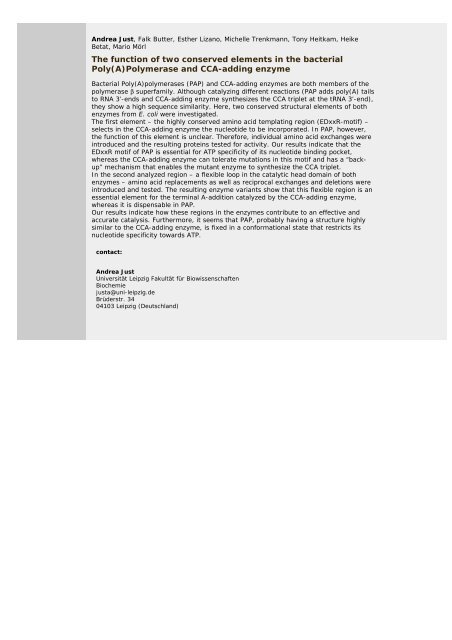Abstracts (poster) - Wissenschaft Online
Abstracts (poster) - Wissenschaft Online
Abstracts (poster) - Wissenschaft Online
You also want an ePaper? Increase the reach of your titles
YUMPU automatically turns print PDFs into web optimized ePapers that Google loves.
Andrea Just, Falk Butter, Esther Lizano, Michelle Trenkmann, Tony Heitkam, Heike<br />
Betat, Mario Mörl<br />
The function of two conserved elements in the bacterial<br />
Poly(A)Polymerase and CCA-adding enzyme<br />
Bacterial Poly(A)polymerases (PAP) and CCA-adding enzymes are both members of the<br />
polymerase β superfamily. Although catalyzing different reactions (PAP adds poly(A) tails<br />
to RNA 3’-ends and CCA-adding enzyme synthesizes the CCA triplet at the tRNA 3’-end),<br />
they show a high sequence similarity. Here, two conserved structural elements of both<br />
enzymes from E. coli were investigated.<br />
The first element – the highly conserved amino acid templating region (EDxxR-motif) –<br />
selects in the CCA-adding enzyme the nucleotide to be incorporated. In PAP, however,<br />
the function of this element is unclear. Therefore, individual amino acid exchanges were<br />
introduced and the resulting proteins tested for activity. Our results indicate that the<br />
EDxxR motif of PAP is essential for ATP specificity of its nucleotide binding pocket,<br />
whereas the CCA-adding enzyme can tolerate mutations in this motif and has a “backup”<br />
mechanism that enables the mutant enzyme to synthesize the CCA triplet.<br />
In the second analyzed region – a flexible loop in the catalytic head domain of both<br />
enzymes – amino acid replacements as well as reciprocal exchanges and deletions were<br />
introduced and tested. The resulting enzyme variants show that this flexible region is an<br />
essential element for the terminal A-addition catalyzed by the CCA-adding enzyme,<br />
whereas it is dispensable in PAP.<br />
Our results indicate how these regions in the enzymes contribute to an effective and<br />
accurate catalysis. Furthermore, it seems that PAP, probably having a structure highly<br />
similar to the CCA-adding enzyme, is fixed in a conformational state that restricts its<br />
nucleotide specificity towards ATP.<br />
contact:<br />
Andrea Just<br />
Universität Leipzig Fakultät für Biowissenschaften<br />
Biochemie<br />
justa@uni-leipzig.de<br />
Brüderstr. 34<br />
04103 Leipzig (Deutschland)

















